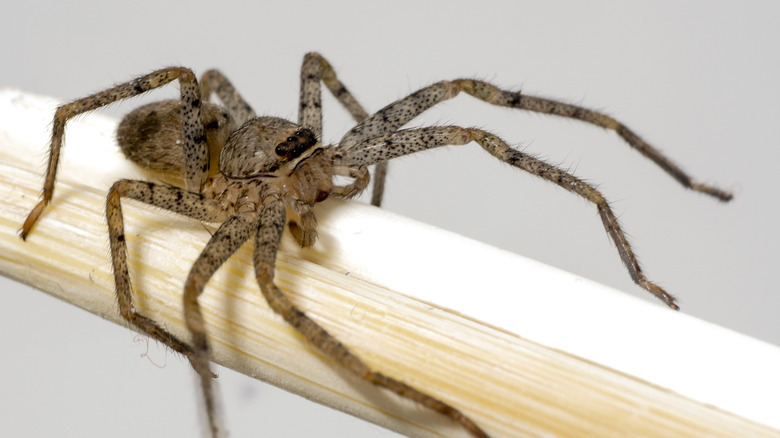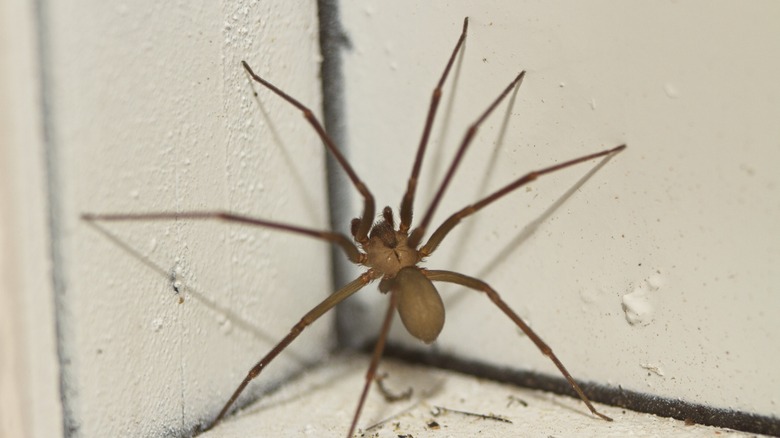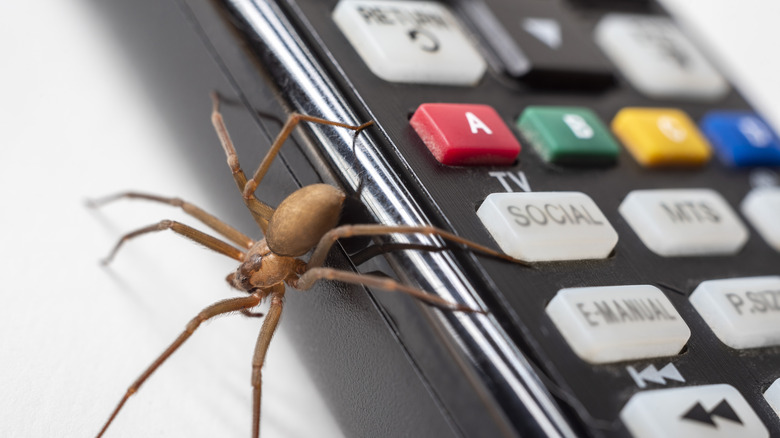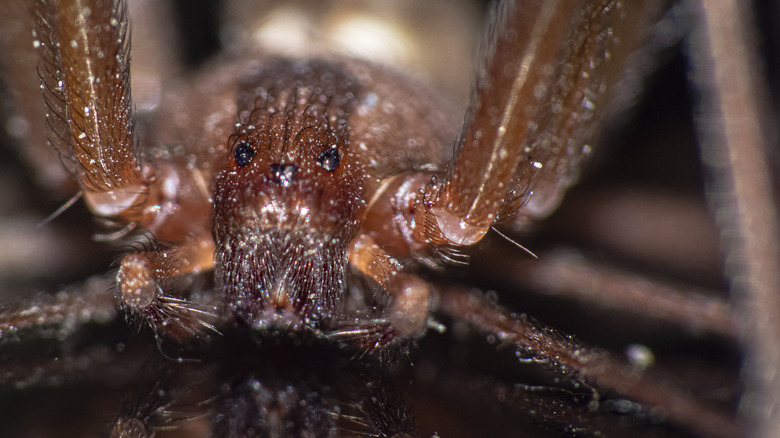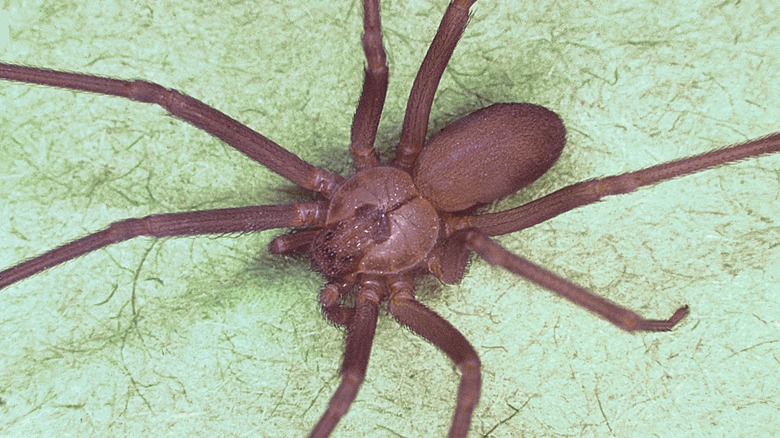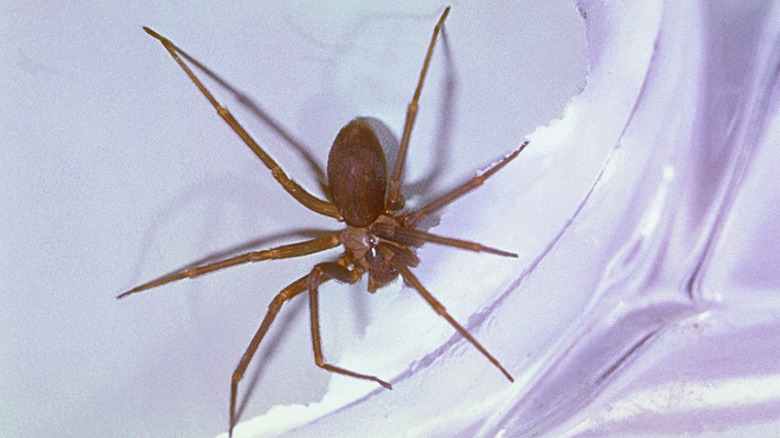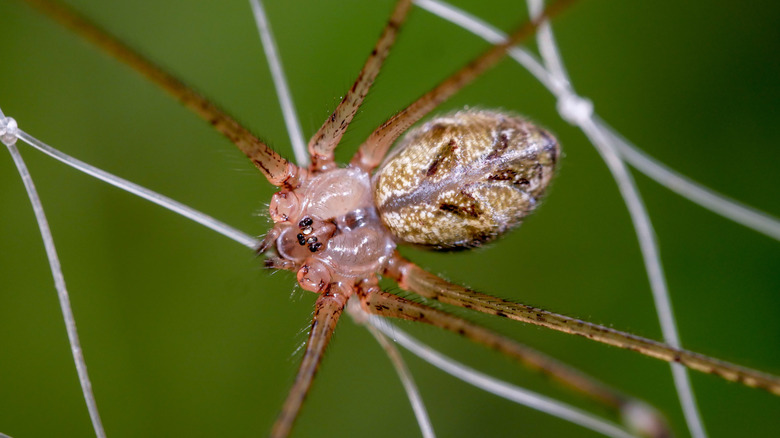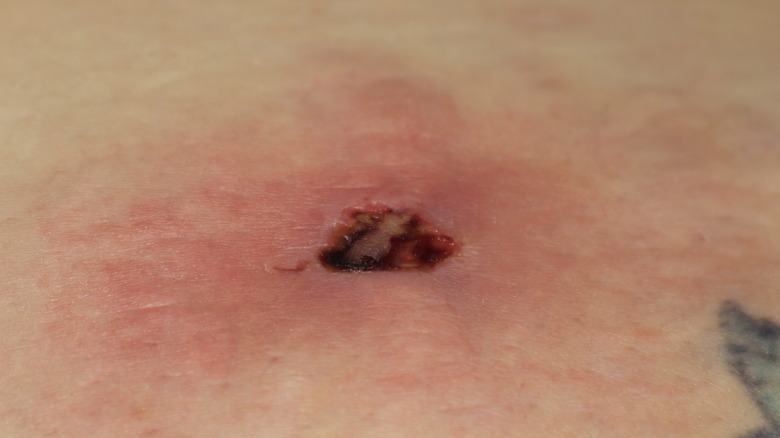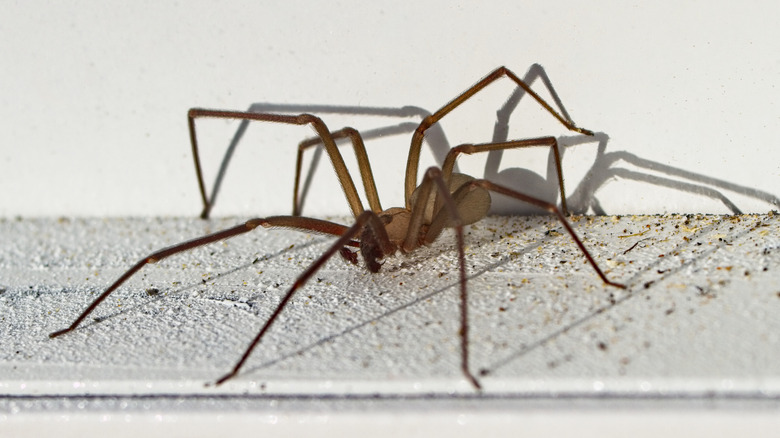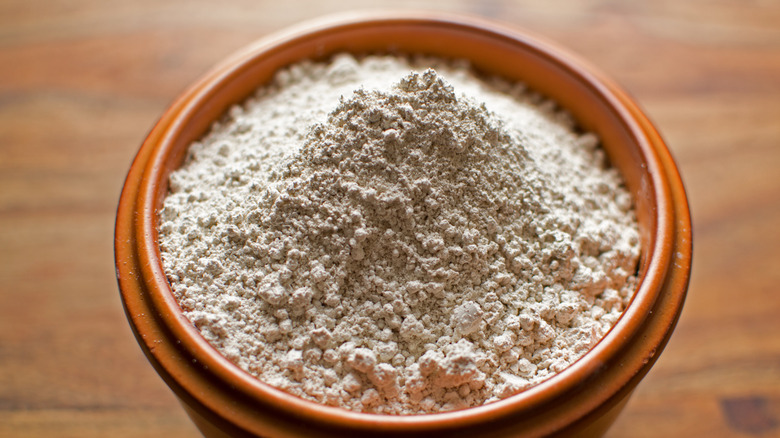How To Identify And Get Rid Of Dangerous Brown Recluse Spiders
Spiders! Some people can share their living space with them quite easily, but for others, a mere glimpse of any kind of arachnid is enough to send them into a blind panic. Although spiders may not be eight-legged monsters who are out to eat you alive, it's a foolhardy soul who would want to live under the same roof as a brown recluse spider. Alongside the black widow and the Chilean recluse, the brown recluse has a venomous bite that can cause serious damage. Fortunately, it isn't as aggressive as its reputation suggests, and it rarely attacks humans. People often mistake other spiders for a brown recluse, so it's important to know exactly how to identify and get rid of them.
Predominantly found in Missouri, Mississippi, Alabama, Arkansas, and Louisiana, brown recluse spiders have also wandered into Ohio, Oklahoma, Tennessee, Texas, Georgia, Illinois, Indiana, Iowa, Kansas, and Kentucky. As their name suggests, these spiders are retiring and unsociable types who make their home in the dark and dry places of your home. Basements, attics, garages, beneath boxes, inside drawers, woodpiles, beds, shoes, and clothing are all places the brown recluse loves. The danger comes when you disturb one of these critters in their lair, and they bite out of fear. To avoid this situation, knowing exactly what you're looking for and how to effectively deal with the problem is always wise.
The clue is in its color
The brown recluse is one of god's critters that does exactly what it said on the tin — it's reclusive in nature and boasts an unmistakable brown or tan shade. Which is extra helpful when it comes to identifying them. Its legs and body are uniform in color. It has no stripes or bands and will never have any contrasting pigmentation. The only discoloration you may notice, and for this you'll need to get extremely close, is its beating heart which is noticeable through the thin fabric of its skin. However, if you're one of those souls that are instantly engulfed by a primal fear at the sight of something eight-legged and scuttling, it's advisable to keep your distance.
It's important to remember that funnel weavers, orb weavers, and male huntsman spiders are often mistaken for brown recluses, but there is a big difference. If you notice that the spider's legs have more than one color of brown or its abdomen is multi-pigmented, then it is definitely not a recluse. The spiders we're dealing with do not like variety and like to keep their color scheme matched! It's rare to spot a brown recluse spider because of its retiring nature, but you can bet your bottom dollar that where there's one, there's bound to be many. So correct identification is key.
Their small size betrays a big bite
Surprising things come in small packages, and considering its tiny size, the brown recluse spider can pack one hell of a punch. An arachnid such as a tarantula has the sort of big, furry, and imposing stature that lives up to its fearsome reputation. On the other hand, when you come face to face with a brown recluse, its tiny and diminutive size betrays a big bite. Even when all their legs are stretched out, these spiders are only about the size of a quarter. However, it's not the size of the dog in the fight, but the size of the fight in the dog, so don't let their puny appearance deceive you. Brown recluses are not the kind of spiders you want to mess with.
To properly identify a brown recluse spider by size, always bear in mind that its body doesn't grow much more than 1/2 of an inch, and with its legs fully stretched, it reaches a size of about one inch. The black widow is relatively the same size as the brown recluse. However, its distinctive coloring means it's never mistaken for its fellow poisonous arachnid. The non-venomous and common wolf spider is sometimes misidentified as a brown recluse, but it tends to be significantly bigger at two inches.
Brown recluse spiders have six eyes, not eight
Perhaps one of the most unsettling aspects about spiders is their cold, indifferent, and predatory eyes. To make matters worse, most spiders don't just have two eyes to penetrate our very souls with. They usually have eight, positioned at the front and side of their heads. This little quirk of nature is because they don't have necks, and having extra eyes helps them to identify prey or predators quicker. However, one of the brown recluse's most identifiable traits is that it has six eyes instead of eight.
Although six eyes are no more socially acceptable than eight, it somewhat lessens the blow. Like most spiders, the brown recluse cannot see all that well, and their extra eyes have evolved to detect brightness and motion and little else. The brown recluse's eyes are arranged in three pairs at the front and side of its head. They're black and beady, and the pair in the middle is slightly lower than the ones on the side. However, if you're studying the spider's eyes and it is not trapped safely inside a glass tumbler, you're already too close, so step back.
They have an unmistakable violin pattern near their heads
If you've ever wondered why brown recluse spiders are sometimes called "fiddle-backed spiders" or "violin spiders," then wonder no more. It's all to do with the odd violin pattern found on their backs and near their heads. Although we more readily associate the violin with the likes of Bach and Paganini, as opposed to a venom-spitting arachnid, the workings of nature are as mysterious as they are infinite.
The violin-shaped blemish can be found at the top of the brown recluse's cephalothorax. This is the part of the spider where their head and thorax become fused together. The "neck" of the violin can be found near the abdomen. If similar markings appear on a spider's abdomen and nowhere else, it is not a brown recluse. The size and intensity of the marking varies from web weaver to weaver, but its distinguishing feature is that it's always a darker color than the brown recluse's body. Some young brown recluse spiders might take a little time to develop the mark, but nearly all full-grown adults carry it to a degree.
They have fine hair without spines
Another tell-tale sign you are dealing with a brown recluse spider and not some other member of the arachnid family is that a brown recluse's legs have a silky appearance because it is covered with fine hair instead of spikes. Whereas most spiders possess coarse and modified hairs on their limbs to help them get a better grip on their prey, brown recluse spiders do not. Their legs are quite long, and thin and have a velvety vibe due to the short, fine hairs, which are difficult to see.
Any spider with spines instead of fine hair or long or matted-looking hair isn't a brown recluse. The legs will also be the same coloration as their body. Another way to identify them is by the position of their legs. The brown recluse's genus name Loxosceles translates as "slanted legs."This is because when recluse spiders are chilling, their legs also take on a diagonal position.
Look for retreat webs in your home
One of the lesser-known, but more intriguing facts about the brown recluse spider is they spin retreat webs as opposed to those used to trap prey. Consequently, whereas other spiders will spin their webs in strategic locations to hunt, a brown recluse will spin its webs in the hidden, undisturbed, and remote corners of your home. Cellars, closets, crawlspaces, basements, and attics are prime locations for the brown recluse's web. Their webs have also been found in storage boxes, tires, shoes, and clothing.
A brown recluse's web is built from the same protein-based silk as other web weavers but is off-white in color, and the design is haphazard and appears rushed compared to more traditional spiral and symmetrical webs. A brown recluse eats insects and does not need to weave webs to hunt. Although they only have an average lifespan of two years, these spiders can survive an amazing 12 months without food or water. The females will use the retreat webs to lay eggs and will stay close to them. The males and younger spiders will typically roam further afield.
What to do if a brown recluse spider bites
If a brown recluse spider has ever bitten you, chances are you won't know a thing about it when it sinks its fangs into you. There's little to no pain, and if there is, it may feel like a mild bee sting. Over the next eight hours, you might notice a red bullseye around the bite mark. This can blister and turn a bluish-black as your skin tissue dies. In most cases, tissue destruction is kept to a minimum, but in 10% of cases, the skin will ulcerate and blister so badly it needs medical attention. Seek a doctor's advice if the bite is accompanied by fever, chills, nausea, weakness, and seizures because the bite of a brown recluse can kill. If you believe your child was bitten, seek medical advice immediately, as their underdeveloped immune system is unable to fight off a brown recluse's poison.
Fortunately, 90% of bites do not warrant medical attention. Rick Vetter, a retired research associate of entomology at the University of California, explained to Live Science that most "heal very nicely, often without medical intervention and treatment." If you are bitten, it is recommended to clean the affected area with some antibiotic cream and adopt the RICE method — rest, ice, compression, and elevation. The injury should heal nicely at home. Brown recluse bites are rare, and it will only usually attack if its habitat is threatened. However, because that habitat could be a pair of shoes or a coat, this could prove a problem.
Various scents can help ward off brown recluse spiders
As well as smelling divine, some scents have almost magical properties that include being able to repel web weavers from entering your home. Spiders are blessed with a powerful sense of smell and use it to decide what and what not to eat. They are also guided by their nostrils when looking for a potential mate. However, there are certain scents they are not fussy about, and which can help keep brown recluses, black widows, and common house spiders at bay.
White vinegar mixed with equal parts water and placed in a spray bottle is an effective way to take the fight to the brown recluse. Spray the mixture liberally once a week in the vicinity where they were last spotted, and give your doors, windows, and all the other entry points in your house a light soaking. Peppermint and mint essential oils mixed with a little water are also great at repelling the creepy crawlies. Although cayenne pepper may just be the thing to liven up a bland dish, it irritates the hell out of spiders, so be sure to sprinkle anywhere they've been spotted scuttling. Citrus essential oils work, but only if they come in direct contact with spiders; the scent alone is not enough to deter them. The smell of horse chestnuts is unbearable to spiders, so a few carefully placed in basements, on windowsills, in pantries, and on your doorstep can work wonders.
Vacuum for victory
A little bit of cleaning is good for the soul. And who doesn't like purging the house of dust and dirt with a vacuum cleaner? Next time you're blowing away the cobwebs, why not try tackling any potential spider infestation by sucking up a few web weavers as well? Sometimes the simplest techniques are the best, and vacuuming any tell-tale webs is as good a means as any of dealing with brown recluse spiders.
Before employing the power of super suction, seek out any dark and hidden corners of your home for the retreat webs that brown recluse spiders love to weave. Look beneath furniture, in closets, and under exposed stairs. Use a long-handled attachment and turn the vacuum to the max. The webs, alongside any spiders and eggs, will be sucked into the cleaner. Dispose of the contents outside, and make sure you wear gloves. With the war nearly won, the last thing you want is to be bitten by an angry and disgruntled brown recluse.
Use a sticky trap
As well as sealing any potential entry points and hiding places for brown recluse spiders, sticky or glue traps can be a godsend. They are non-toxic, easy to use, and can halt a spider infestation in its tracks. Its sticky adhesive will ensnare all the web weavers that walk across the traps. As well as nipping your problem in the bud, it can help you gauge the true extent of how many brown recluses you have in your home.
For best results, position the sticky traps in all the areas where you've noticed a spider presence. It's important to dispose of used traps when full, and always wear gloves when discarding them. Although they contain no dangerous chemicals, keeping children away from them is always wise. Keeps pets at a safe distance to prevent them from getting sticky paws or the terrible temptation of chowing down on some stranded spiders.
Sprinkle a little diatomaceous earth
Diatomaceous earth is simply fossilized algae that has been broken down into powder. It can be found in the earth's oceans, lakes, rivers, and streams, and has a first-class reputation as an effective pesticide and insecticide. Next time you notice a brown recluse spider scuttling across your floor space, you might want to invite some diatomaceous earth to the party. If you have young children or pets and are wary about using chemicals in the home, diatomaceous earth is a reliable and safe way to deal with any spider infestation.
Diatomaceous earth is not as quick as other methods, but it is one you can count upon. The crushed sedimentary rock works by wounding the bodies of brown recluse spiders, attacking their exoskeletons and eventually killing them over a few days. It's not pretty, but neither is the bite of a brown recluse. To use this sand-like silica compound, simply sprinkle a light covering into any tiny crack or entry points you suspect spiders are using to gain access to your home and wait for the results.
Unleash the power of insecticides
If all else fails and you're at your wits end with the amount of brown recluse spiders invading your home, it might be time to bring out the big guns. Insecticides may be full of toxic chemicals, but they are more challenging for spiders to avoid than sticky traps and diatomaceous earth. If all other prevention methods and more organic ways to deal with your infestation have failed, then the benefits of using insecticides in your home far outweigh the risks.
Products containing either cyhalothrin, cyfluthrin, bifenthrin, deltamethrin, or lambda are effective all-rounders that work well against brown recluse spiders. It doesn't matter if you opt for liquid, dust, or spray forms — just be sure to target the usual cracks and crannies where the brown recluses might be lurking or using as an entry point into your home. Always follow the instructions on any product, wear protective equipment, and ensure children or pets do not go anywhere near these chemical agents, which can pose risks if inhaled or ingested.
If in doubt, call in the professionals
If you've tried and failed to deal with your brown recluse spider infestation or are not confident about tackling it yourself, it may be time to call in the professionals. There are many good reasons for employing expert help. First, they have reservoirs of experience to draw upon and tried and tested means of dealing with a specific problem. They know exactly what products to use and where to apply them and are extremely knowledgeable in the ways and habitats of the brown recluse spider.
Secondly, they are trained to adhere to rigorous safety measures when dealing with an infestation. Thirdly, they will ensure that all spiders have been removed from your home during the procedure and offer help and advice to prevent them from returning. Last but not least, a professional service provides complete peace of mind that your brown recluse spider problem is in the safest and most capable pair of hands.
